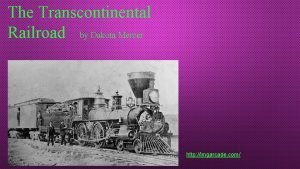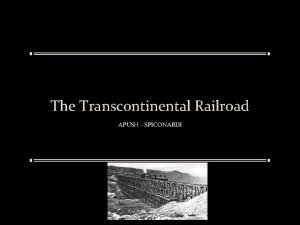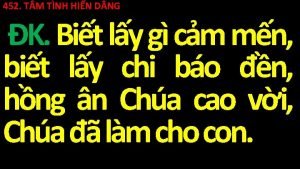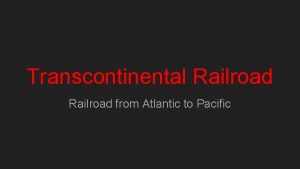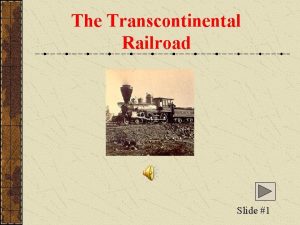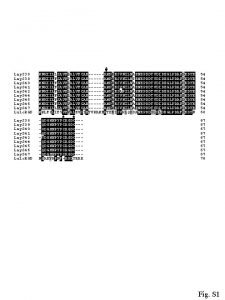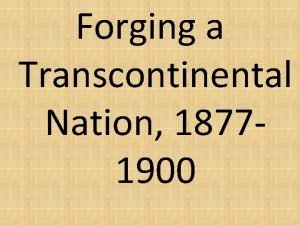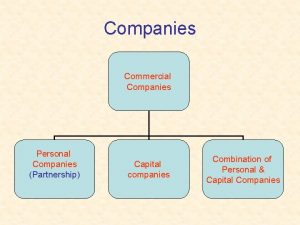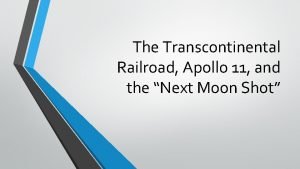The Transcontinental Railroad Railroad companies raced to lay











- Slides: 11

The Transcontinental Railroad · Railroad companies raced to lay tracks to the mines in order to supply the miners. J j

"End of Track, near Humboldt Lake, " circa 1868, showing a May of 1997; it appears if the freight trailwith can lots stillofbetents seen construction train stopped, asheaded eastbound, in the foreground. These tents were probably occupied by Chinese, whose contribution to the construction of this railroad made the Transcontinental Railroad a reality.

Promontory Point, Utah . Central Pacific Railroad x Omaha, Nebraska . Union Pacific Railroad J j Sacramento, California · In 1863, two companies, the Union Pacific and the Central Pacific, began building the first transcontinental railroad.

“White manpower, the kind employers preferred, was in desperately short supply, diverted by the call to arms or the shout of “Eureka!” in the goldfields. The few white recruits who did straggle in…leaned on their picks when the boss rode away and shouldered their shovels on payday. ” Central Pacific approximately 90% of their workforce were Chinese immigrants Immigrant Workers · Labor was Union Pacific - scarce due to the hired many hard, dangerous Irish work and low immigrants pay. · Therefore, immigrant labor was used.

· The workers endured scorching deserts, blinding snowstorms, and blasted through mountains. Chinese railroad workers perform their duties in the snow.


“This ‘cape’ was a wall of rock 2, 700 feet high, rising steeply from the American River and largely innocent of even a toehold. But the Chinese wove large wicker baskets, marked them with bright symbols to ward off evil spirits, and at the sound of the sunrise whistle marched silently off to the ridgetop. From one end of their bamboo carrying poles hung discarded kegs filled with strong tea; from the other, their woven baskets…Lowered in the baskets hundreds of feet down the cliff they chipped and chiseled small nooks out of the rock, inserted charges of black powder, then nimbly scampered up the ropes, pulling their baskets out of harm’s way as the fuses crackled and flashed. ”

On May 10, 1869, a golden spike was hammered into a track joining the two tracks in Promontory Point, UT.

Gold-plated Golden Spike that was donated by the governor of Arizona Territory. Spike is now owned by the Museum of the City of New York. Photo by poster, 12/06


“At Promontory Point, Utah, on May 10, 1869 – when the rival rails were joined with great fanfare – the Chinese finished the job. But there and elsewhere, Crocker’s Asians were excluded from the festivities. (Charles Crocker was the chief overseer of the Central Pacific Railroad’s works. ) At San Francisco’s grand celebration, the keynote speaker attributed the railroad’s existence to ‘the commingled blood of the four greatest nationalities of modern days’ – the French, Germans, English, and Irish of America. And at a centennial observance in 1969, Secretary of Transportation John A. Volpe echoed the sentiment: “Who else but Americans, ” he intoned, “could drill ten tunnels in mountains thirty feet deep in snow? Who else but Americans…? ”
 The apostate jack london
The apostate jack london Industrial revolution
Industrial revolution Transcontinental railroad manifest destiny
Transcontinental railroad manifest destiny Ducksters transcontinental railroad
Ducksters transcontinental railroad Who helped build the transcontinental railroad
Who helped build the transcontinental railroad Transcontinental railroad apush
Transcontinental railroad apush Who helped build the transcontinental railroad
Who helped build the transcontinental railroad Transcontinental railroad
Transcontinental railroad The horse raced past the barn fell
The horse raced past the barn fell Biết lấy gì cảm mến biết lấy chi báo đền
Biết lấy gì cảm mến biết lấy chi báo đền Hệ hô hấp
Hệ hô hấp Tư thế ngồi viết
Tư thế ngồi viết



